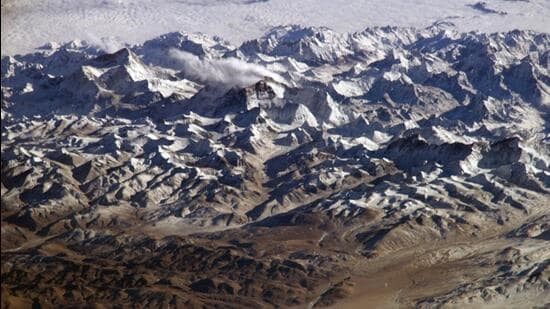SPIKE IN AEROSOL IN HINDU KUSH REGION

Disclaimer: Copyright infringement not intended.
Context
- The Hindu Kush-Himalaya-Tibetan Plateau region has been experiencing a notable surge in aerosol levels.
Findings of ISRO’s PRL Study
- Aerosol radiative forcing efficiency (ARFE) was higher in the Himalayan foothills.
- This indicates the significant impact of anthropogenic aerosols on the radiative fluxes in the atmosphere.
- Annual mean aerosol-induced atmospheric heating rates were found to be considerably higher in this region.
- Aerosols alone could account for over 50% of the total warming.
Challenges in Climate Assessments
- Existing climate assessment models significantly underestimate aerosol-induced heating.
- There is a need for a more realistic representation of aerosol properties in these models.
Implications for the Region
- Consequences:
- increased temperatures,
- altered rainfall patterns,
- accelerated glacier retreat, and
- instigated changes in the hydrological cycle.
Concerns for Glacier Retreat
- The Hindu Kush-Himalaya-Tibetan Plateau region is home to a substantial ice mass.
- It has witnessed significant glacier retreat.
- This poses threats to the sustainability of the rivers in the region, affecting billions of lives and livelihoods.
Broader Context
- The study's findings align with previous reports.
- The 2019 International Centre for Integrated Mountain Development (ICIMOD) report highlighted the region's vulnerability to rising temperatures.
- It stressed the critical significance of limiting global warming to 1.5 degrees Celsius for the Himalayas' sustainability.
About Aerosols
- Aerosols are tiny solid or liquid particles suspended in the atmosphere.
Types of Aerosols:
- Natural Aerosols are formed by natural processes such as dust storms, sea spray, volcanic eruptions, and wildfires.
- Anthropogenic Aerosols are generated from human activities, (industrial processes, vehicle emissions, and the burning of fossil fuels).
Properties of Aerosols:
- Aerosols can vary widely in size, ranging from a few nanometers to several tens of micrometers.
- They can consist of sulfates, nitrates, organic compounds, black carbon, mineral dust, and sea salt.
- Aerosols have varying lifetimes in the atmosphere (ranging from a few hours to several days).
Effects on Climate:
- Aerosols can directly influence climate by scattering and absorbing sunlight, leading to cooling or warming effects depending on their properties.
- Aerosols can also act as cloud condensation nuclei, altering cloud properties and affecting cloud formation, lifetime, and precipitation patterns.
Air Quality and Human Health:
- Inhalation of aerosols can lead to various respiratory problems, including asthma, bronchitis, and other lung-related diseases.
- Aerosols can contribute to smog formation, reducing visibility and degrading air quality.
Global Significance:
- International Cooperation is necessary as aerosols can travel across continents and impact regional climates.
Conclusion
Understanding the diverse impacts of aerosols is crucial for developing effective policies to mitigate climate change, improve air quality, and protect human health on a global scale.
|
PRACTICE QUESTION Q.Discuss the implications of the recent surge in aerosol levels in the Hindu Kush-Himalaya-Tibetan Plateau region as highlighted by a study conducted by the Indian Space Research Organisation's (Isro) Physical Research Laboratory. Elaborate on the potential effects of aerosols on the climate, glacier retreat, and hydrological patterns in the region. (250 Words) |





1.png)
